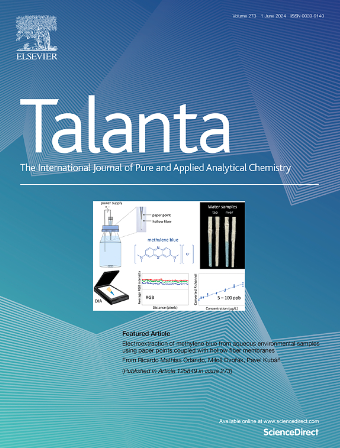水凝胶包被的微针生物传感器在皮肤模拟间质液幻象中用于选择性和低电位葡萄糖检测
IF 5.6
1区 化学
Q1 CHEMISTRY, ANALYTICAL
引用次数: 0
摘要
用于连续血糖监测的微创生物传感器的发展引起了人们的广泛关注,以提高患者的依从性和舒适度。在这项研究中,设计和制造了一种水凝胶包被的微针(MN)生物传感器,用于模拟皮肤间质液(ISF)模型中葡萄糖的选择性和低电位电化学检测。用葡萄糖氧化酶(GOx)-壳聚糖复合材料修饰不锈钢MNs,并将其进一步封装在海藻酸-聚乙烯醇(Alg-PVA)水凝胶基质中,以增强生物相容性和分析物的扩散。优化了GOx固定方法、水凝胶组成和干燥工艺。循环伏安法(CV)证实了制备的成功和有效的电子转移。该传感器在磷酸盐缓冲盐水(PBS)中的线性检测范围为1.0 ~ 50.0 mM,检出限(LOD)为0.11 mM;在人工ISF中的线性检测范围为1.0 ~ 40.0 mM, LOD为0.20 mM。优化后的低工作电位(−0.2 V)显著降低了抗坏血酸(AA)、尿酸(UA)和对乙酰氨基酚(AP)等常见电活性物质的干扰。稳定性评估显示在14天的存储期内具有出色的重复性(RSD < 4%)和可靠的性能。此外,在模拟皮肤的凝胶PBS和人工ISF模型中进行的葡萄糖测量显示,线性响应范围为1.0-25 mM, LOD为0.11 mM,线性响应范围为1.0-40.0 mM, LOD为0.46 mM。这些结果证明了水凝胶包被微针生物传感器在生理相关条件下精确、无痛和实时血糖监测的实用性和可靠性,突出了其可穿戴医疗保健应用的潜力。本文章由计算机程序翻译,如有差异,请以英文原文为准。

Hydrogel-coated microneedle biosensor for selective and low-potential glucose detection in skin-mimicking interstitial fluid phantoms
The development of minimally invasive biosensors for continuous glucose monitoring has attracted considerable attention to improve patient compliance and comfort. In this study, a hydrogel-coated microneedle (MN) biosensor was designed and fabricated for the selective and low-potential electrochemical detection of glucose in skin-mimicking interstitial fluid (ISF) phantoms. Stainless steel MNs were modified with a glucose oxidase (GOx)-chitosan composite and further encapsulated within an alginate-polyvinyl alcohol (Alg-PVA) hydrogel matrix to enhance biocompatibility and analyte diffusion. The GOx immobilization method, the hydrogel composition, and the drying process were optimized. Cyclic voltammetry (CV) confirmed successful fabrication and efficient electron transfer. The biosensor exhibited a wide linear detection range of 1.0–50.0 mM with a limit of detection (LOD) of 0.11 mM in phosphate-buffered saline (PBS) and a linear range of 1.0–40.0 mM with an LOD of 0.20 mM in artificial ISF. The optimized low operating potential (−0.2 V) significantly minimized interference from common electroactive species such as ascorbic acid (AA), uric acid (UA), and acetaminophen (AP). Stability assessments demonstrated excellent repeatability (RSD <4 %) and reliable performance over a 14-day storage period. Furthermore, glucose measurements performed in skin-mimicking gel-based PBS and artificial ISF phantoms exhibited a linear response range of 1.0–25 mM and an LOD of 0.11 mM and linear response range of 1.0–40.0 mM and an LOD of 0.46 mM, respectively. These results demonstrate the practical applicability and reliability of the hydrogel-coated microneedle biosensor for accurate, painless, and real-time glucose monitoring under physiologically relevant conditions, highlighting its potential for wearable healthcare applications.
求助全文
通过发布文献求助,成功后即可免费获取论文全文。
去求助
来源期刊

Talanta
化学-分析化学
CiteScore
12.30
自引率
4.90%
发文量
861
审稿时长
29 days
期刊介绍:
Talanta provides a forum for the publication of original research papers, short communications, and critical reviews in all branches of pure and applied analytical chemistry. Papers are evaluated based on established guidelines, including the fundamental nature of the study, scientific novelty, substantial improvement or advantage over existing technology or methods, and demonstrated analytical applicability. Original research papers on fundamental studies, and on novel sensor and instrumentation developments, are encouraged. Novel or improved applications in areas such as clinical and biological chemistry, environmental analysis, geochemistry, materials science and engineering, and analytical platforms for omics development are welcome.
Analytical performance of methods should be determined, including interference and matrix effects, and methods should be validated by comparison with a standard method, or analysis of a certified reference material. Simple spiking recoveries may not be sufficient. The developed method should especially comprise information on selectivity, sensitivity, detection limits, accuracy, and reliability. However, applying official validation or robustness studies to a routine method or technique does not necessarily constitute novelty. Proper statistical treatment of the data should be provided. Relevant literature should be cited, including related publications by the authors, and authors should discuss how their proposed methodology compares with previously reported methods.
 求助内容:
求助内容: 应助结果提醒方式:
应助结果提醒方式:


